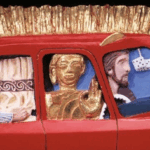In 2016, Disney released Rogue One, a Star Wars prequel set shortly before the events of Star Wars: A New Hope. The film was well-received, praised by critics and fans for its tense depiction of what it takes to be a hero and the concept of martyrdom. The subject of death came up in a different way, however, and the film was the source of controversy. The reason for this was Lucasfilm’s use of an actor who passed away decades ago. With the permission of his estate, the film used the voice and image of Peter Cushing, a veteran British actor who died in 1994. Rogue One’s CGI, closely captured the actor’s likeness, but it was remarkable for what Japanese roboticist Mashahiro Mori called The ‘Uncanny valley’, where a piece of artificial intelligence looks close to the real thing, but is unsettling.
Even though Lucasfilm had the permission of Cushing’s estate, critics also questioned whether or not it was ethical to use his likeness when he could never give consent. As Kristy Puchko writes, “the fact remains: Cushing couldn’t say no.”
“As much as the public prefers to think of actors as personas not people, we — and the studios — do not own them,” she argues.
“And so to take their likeness and voices and reconstruct them to new end when they can’t consent is repugnant and wrong.”
As Rich Firth-Godbehere writes, seeing the deceased in a healthy state can be unnerving, “ I can’t help but wonder if the reintroduction of youth and perfect health …qualifies as a reminder of death and ill-health?”
This case is one of a few that bring up the question, “Is it OK to bring back the dead?” Or at least, is it ethical to use their voice and likeness to recreate what they were like when they were alive?
The idea of bringing back the dead (or at least, making a digital surrogate of them) has a wider cache in the popular imagination. Bioshock 2: Minerva’s Den and an episode of Black Mirror called ‘Be Right Back’ are two examples of it in entertainment. Both feature the stories of people who try to resurrect their loved ones by way of recordings of their voices and memories, drawing on these to have conversations with them as though they were still around and able to answer questions. Both stories end with the protagonist regretting their decision to try to resurrect their loved one.
Other stories feature this concept but don’t overtly problematise it, including Minority Report.
As technology continues to progress, these kinds of fictional examples seem closer to reality, and there have been some early experiments into making digital surrogates of the dead.
Hossein Rahnama of Ryerson University and the MIT Media Lab is currently working on making chatbots crafted from personal data, including emails, texts, tweets, and snapchats. The idea here is that, much like in the Black Mirror episode, someone could type messages to the deceased person and receive a reply from an AI that had been programmed to mimic that person.
“Fifty or sixty years from now, [people] will have reached a point in their lives where they each will have collected zettabytes [1 trillion gigabytes] of data, which is just what is needed to create a digital version of yourself,” Rahnama said.
While this might allow people to grieve and process the loss of a loved one, Rahmana argues that an individual’s privacy must be paramount when it comes to passing on virtual profiles.
“You should be able to own your data and only pass it along to people you trust, so allowing people to engage with their own ancestors would be likely.”
Slightly different to Rahnama’s experiment is another project, launched by a Russian AI company, Luka. Eugenia Kuyda, the company’s co-founder, aimed to make a chatbot that would resemble her late best friend, Roman Mazurenko, who was killed in a car accident in 2015. Users of the Luka app can chat to the ‘Roman’ chatbot. While Kuyda is happy that the chatbot captures much of her friend’s wit, it is not a substitute. “It’s more like a shadow of a person,” she said.
It should also be noted that seeing and hearing a deceased loved one is nothing altogether new, and that these illusory experiences are relatively common among widowed people and are often considered to be a healthy coping mechanism. One Welsh study found that 13 percent of elderly widows and widowers had heard their dead loved one’s voice and 14 percent had seen them. As Dr Simon McCarthy-Jones writes, “people should think twice about judging these experiences harshly…we should perhaps simply be marveling at the power of love.”
Holding the ability to converse with someone who is gone, then, might help the grieving process. In a Quartz article, Toronto-based grief counsellor Andrea Warnick is quoted as saying that she sees potential value in digital afterlife technology, in that it may facilitate conversations among family and friendship networks, about the person who has died.
“In modern society, many people are hesitant to talk about someone who has died for fear of upsetting those who are grieving—so perhaps the importance of continuing to share stories and advice from someone who has died is something that we humans can learn from chatbot,” she said.
Of course, the Bible says nothing about this subject directly. Like many things, this is a new problem that the biblical writers could not have foreseen in their immediate context. And yet, as Douglas John Hall writes, the church must deal with issues that are not directly addressed in scripture all of the time (Hall cites same-sex marriage as an issue that is not explicitly dealt with in scripture, but is nonetheless the subject of debate that draws on broader scriptural principles). As services that record the dead’s voice and likeness become available, this issue may be one the church finds itself wrestling with in the future.












